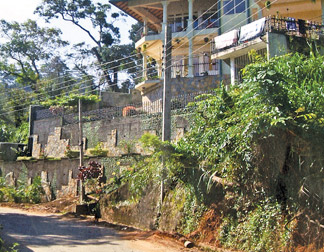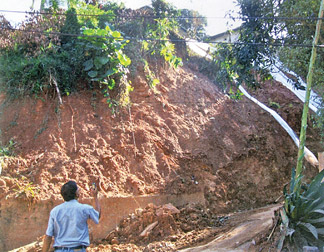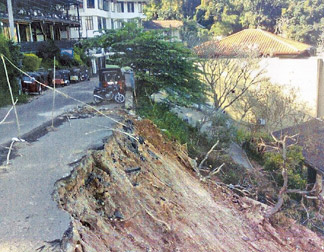|
Landslides - Kandy more prone:
Averting a future disaster
by A. Mahinda SAMARASINGHE
The purpose of this article is to alert both the public and the
authorities to the real danger posed by potential future landslides in
Kandy, or, in particular, to highlight the threat posed to private
dwellings and other buildings such as schools that lie on the path of
potential landslides endangering life and property. The intention of
this write-up is not to sensationalise or bring undue fear to people,
but to create awareness on the seriousness of the problem for the
benefit of the affected people and to alert authorities on the need for
prompt action.
Furthermore, appropriate short-term and long-term remedial measures
that can be taken are mentioned for the benefit of those affected from
landslides in Kandy to counter this new grave problem that has suddenly
descended on the Kandy hills.
It is emphasised that the authorities need to take substantial action
such as drawing up and enforcing new codes of Practice to regulate
building construction and other human activities on the hill slopes of
Kandy because, unlike other hilly regions of Sri Lanka, Kandy is a
heavily built-up area and building work continues to expand.
A large number of landslides have already occurred in Kandy in
January 2011. Therefore, urgent action is also needed to implement
suitable remedial measures to mitigate and control the landslide problem
in the potential landslide zones of Kandy.
 |
|
Example of a proper development on the
hill slopes of Kandy: a cascading series of retaining walls
built above
the road |
Although this report details the landslide problem in Kandy, the
basic facts stated herein are applicable to developments carried out in
any other hill zone in Sri Lanka that faces the landslide hazard.
Main cause
While landslides are common in most hilly areas of Sri Lanka, it was
quite puzzling as to why so many landslides occurred in the Kandy hills,
all of a sudden, in January 2011. In the past, Kandy did not suffer many
landslides compared to other hilly areas of Sri Lanka (such as Nuwara
Eliya, Badulla, Hali-ela and Ratnapura) which experienced multitudes of
continuous and serious landslide problems over so many years during
rainy seasons. Hence, it became necessary to look for a possible clue
for the sudden spate of widespread landslides suffered by Kandy.
Consequently, both rainfall records as well as any possible
occurrence of ground tremors were looked into. Initial inquiries from
the Geological Survey Department indicated that the Pallekelle
seismograph (one of three earthquake recording stations in Sri lanka -
as informed by an officer from the Department), has not recorded any
significant earth tremor in recent times.
However, checking the rainfall data at the Meteorological Department
clearly indicated that a very unusual rainfall event which can be
categorised as (in civil engineering terms) a peak “event of 60 years or
more” has taken place during the months of December 2010 to January
2011. This can be further elaborated as follows.
What affects landslides is the cumulative effect of both the amount
of rainfall as well as the rainfall duration period. This is because,
the longer a continuous rainfall period lasts, the greater the wetting
of ground from absorption of water.
When rain is continuous over a longer period of time, more water can
seep into the ground causing the soil-overburden on hill slopes to
become weaker and heavier, creating greater potential for the earth to
slide down the hill.
When rainfall amount and duration data for Kandy were checked for the
past 60 years (no records were available beyond 60 years), it became
very clear that the January 2011 event was the worst such event -
accounting for a cumulative affect of rainfall amount and duration of a
continuous rain period - that has occurred during the past 60 years (or
possibly more).
While rainfall amount and duration are the primary factors that
contribute to landslides, clearing and cutting on hill slopes for
development work such as construction of buildings (as was the case with
most hill slopes of Kandy) also made a secondary contribution towards
landslips.
It should also be emphasised that the blame for landslides does not
lie on the peak rainfall event alone. Obviously, the blame also lies
with human failure to take adequate precautionary measures on the
developments carried out on the Kandy hills.
During a short tour taken through the Kandy town region on January
22, it was possible to see numerous landslides throughout the Kandy
hills. Many of the landslides observed had taken place on the cut/fill
areas adjacent to buildings.
Also, these landslides which mark the commencement of earthslips in
those locations expose the nearby buildings to danger from future slides
that can occur when severe rain period recur. The pictures clearly
indicate the present precarious state of various buildings after the
initial landslides of January 2011.
A critical point that needs to be highlighted here is the enormous
danger posed to schoolchildren who occupy classrooms that lie on the
path of landslides already initiated on the hill slopes of Kandy. They
need quick remedial measures to be taken.
Need for urgent regulations
It is true that rain water causes landslides to occur. However,
failure to adhere to proper Codes of Practice in hillside development
work has been the major reason why most of those Kandy landslides
occurred.
If proper measures such as construction of earth retaining structures
and providing adequate means of storm water drainage were taken, many of
these landslides could have been prevented from taking place.
If proper regulations governing hillside development work are not
established and enforced, the landslide problem in Kandy will continue
to get worse during prolonged rainy periods, resulting in enormous
threats to life and property in Kandy. Any illegal development work on
the hill slopes can be considered a criminal offence because of the
landslide danger posed to those living below and above the development.
In particular, very stringent legislation should be drawn up to protect
schoolchildren and school buildings when any development work is
permitted above an existing school.
It should be mentioned here that in advanced countries such as the
USA and Australia, before any such development is approved by the
relevant local authorities, a soils/ geotechnical report indicating all
the necessary earth retaining structures and foundations., must be
submitted for assessment by competent engineers of the local authority,
such as the City Council. In those countries, let alone hillside
developments, in general, a geotechnical report needs to be submitted in
the construction of even a single-storey dwelling on flat land!
There is a lot that we need to learn because we have been permitting
new development work on our hill slopes without any requirement of a
geotechnical assessment, thus endangering the life and property of those
who live below or above the new development. In particular, all existing
developments located above school or other public buildings should be
subject to complete and urgent reviews to assess any possible threat of
landslides and, if necessary, to implement suitable precautionary
measures.
Suggestions
Formation of a geotechnical authority for Kandy
It could be a committee, headed by a geotechnical engineer, formed
from engineers and other scientists already employed by the government
and/ or private sectors in Kandy including lecturers of geotechnical
engineering from the Engineering Faculty of the Peradeniya Campus. For
such a body to be effective, the engineers and scientists should
preferably reside in Kandy so that they could promptly attend to
landslide emergencies in Kandy, thus avoiding delays that could increase
the danger to life and property.
Public representations for action
Those living in the Kandy hills, for their own interests, should
organise themselves and make representations to the authorities such as
the Kandy Municipal Council or Urban Development Authority to compel
them to appoint a committee to oversee and advise on matters relating to
the landslide problem in the Kandy region. People do need protection for
their lives, as well as their dwellings and access roads.
What building owners can doto alleviate the problem
 |
|
A roadside earthslip on
Rajapihilla Mawatha near Vase park |
Owners of affected buildings can consult qualified geotechnical
engineers to seek appropriate remedial measures such as the construction
of retaining walls. However, in many instances, it will be obvious even
to a non-technical person that provision of simple, sufficiently strong
retaining walls accompanied by suitable drainage facilities at site will
suffice to arrest the landslide problem.
The retaining walls should have weep holes and perhaps lateral drains
to release build-up of water pressure behind the walls. It should also
be pointed out that the cost of retaining walls would be minuscule
compared to the potential loss one would suffer from damage to or loss
of buildings in landslides not to mention the threat to life.
Short-term remedial measures
Earthslides can become progressive with time because the earth
situated on hill slopes has the potential to slide down when weakened by
the absorption of rain water and from other human activities, such as
cutting of slopes, denuding of slopes from vegetation and failing to
provide adequate drainage conditions. When landslides commence, unless
proper corrective measures are taken, progressive slipping of earth will
continue to take place during future rain periods. Since landslides are
caused mainly after rainfalls, it is prudential to take some immediate
low-cost remedial measures to mitigate the progression of the landslides
that have already been initiated on the slopes. If such simple measures
are not taken immediately, the potential is there for the landslide
situation to be greatly aggravated from future rainfalls with the
increased potential for further loss of property and danger to life, and
also necessitating more expensive corrective measures in the future.
Some simple measures that can be adopted to mitigate the existing
landslide problem are as follows:
* Inspect the site well and cut temporary surface drains to divert
the rainwater away from the affected landslide zones. Make sure that the
water is diverted to the existing permanent drain system or safe areas
within the premises so that the water from the temporary drains will not
lead to new landslide problems elsewhere.
* Close all ground cracks, particularly those on the upper slopes,
with clayey soils to minimise the seepage of rainwater into the
potential landslip zone.
* Re-vegetation of any surfaces that are exposed or denuded
* Use a mortar mix (e.g.) 1:4 cement:sand) to make markers on the
cracks. The markers can be made by filling a small length of a crack (20
cm or longer) with the mortar mix so that future movements of the slip
can be monitored easily by visual inspection with the passage of time.
This visual inspection can be used to identify areas needing more urgent
corrective measures ahead of other slip areas.
Long-term remedial measures
For each landslide site, long-term remedial measures should be
decided after carrying out sufficient geotechnical investigations and
analysis. Often, a simple visual inspection will be enough to decide on
the corrective measure needed.
Determining existing building foundations in relation to the bedrock
profile.
Such information is of prime importance to establish the safety of
buildings that face landslide threats and to determine the extent of
corrective measures needed. If any available geotechnical reports and/
or structural drawings of the affected buildings show that the building
foundations are directly resting on the rock instead of the soil
overburden, then those buildings will be mainly safe unless any problems
exist with the bedrock itself. Obtaining these data from existing past
reports and engineering drawings is essential to carry out the
corrective measures properly and to prevent doing expensive remedial
measures that are unnecessary.
Possible corrective measures
Possible corrective measures could include all, or a combination
chosen from the following:
* Retaining walls
* Ground-anchors (soil nails)
* Proper surface water drains and sloping of surfaces to prevent
ponding of water
* Filling of ground cracks with clayey soils
* Re-vegetation of slopes
* Any other appropriate measures
Important considerations
Prioritizing sites for remedial measures
Upon investigations and analysis, the landslide sites that appear to
be most risky and urgent should be selected for remedial measures based
on a priority list of sites.
Safety considerations
Needless to say, the safety of occupants of buildings is of absolute
priority. Particular emphasis is given to buildings such as schools
where large numbers of students congregate.
While classrooms may be used in dry weather periods, during severe
rainy period, students should be removed from classrooms that face the
landslide hazard unless sufficient long-term corrective measures have
been taken.
Urgent attention is observed to be needed at Dharmaraja College,
Vidyartha College, Gothami Balika Vidyalaya and Hillwood College in
Kandy.
The need to be prepared for the danger posed by possible global
climatic change effects
The much talked about ‘Global Warming with Greenhouse Effect’, which
is suspected to have caused drastic changes in weather patterns all over
the world (e.g. worst ever flood disaster in Brisbane, Australia and
extensive landslides in Brazil causing over 600 deaths) may be the
reason for the Kandy peak rainfall event of January 2011, that led to a
large number of landslides on the hill slopes of Kandy.
 |
|
Classrooms of Gothami Balika Vidyalaya
near Vase Park are in
the path of landslides. |
Under such global changes, it is not possible to rule out the
recurrence of another peak rainfall event in Kandy at anytime in the
future. Hence, it is only prudential to be prepared for any such
eventuality, which means proper landslide corrective measures should be
taken as soon as possible on all the potentially unstable built-up areas
of Kandy.
Continuous monitoring of sites in the future and taking preventive
action
As landslides have already started in the Kandy hills, it is
necessary to continuously monitor the slopes in the future. Simple
inspection of the ground for possible future landslips is very important
for early warning signs. There could be areas that have undergone small
slip movements, but have gone unnoticed at present but could move
further after future rainfalls.
Mortar markers can also be used.We may be inclined to be complacent
and assume that the hill slopes are standing fine at present and hence
there is no imminent danger. However, the historical records of other
Sri Lankan hills clearly indicate that every time major rainfall periods
occur, landslides continue to take place there.
Unlike many other hills that are sparsely populated, the risk to life
and property is very high in Kandy due to the high level of developments
on the Kandy hills. It is prudential to take appropriate action in
readiness for a worst case scenario as it did in January 2011, instead
of conveniently assuming that the hills seem all right and take no
preventive action when it is obvious that a real danger exists on the
hills.
The writer is a Chartered Engineer, Geotechnical Specialist and
former head of the Geotechnical and Landslides Division of NBRO.
|

